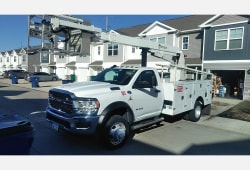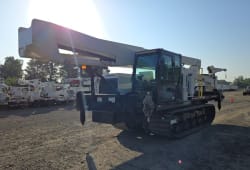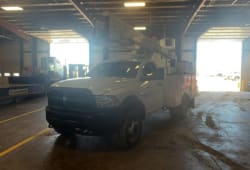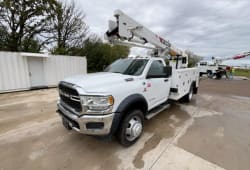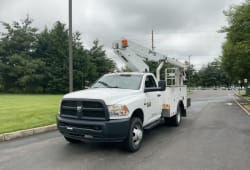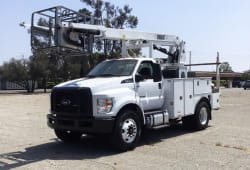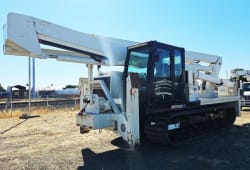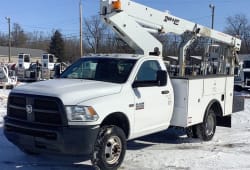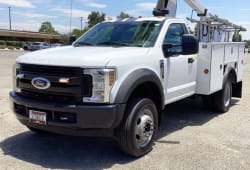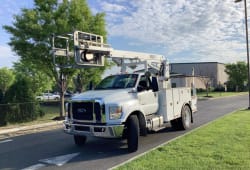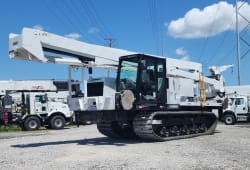The Future of Bucket Trucks: Emerging Technologies and Advancements in Aerial Equipment
10 Min read
)
January 27, 2024
The landscape of aerial equipment, particularly bucket trucks, is evolving rapidly with the advent of new technologies and innovations. As we look towards the future, several emerging trends and advancements promise to revolutionize the way these vehicles are used in industries ranging from utilities to telecommunications and construction. In this blog, we'll delve into some of the most significant developments shaping the future of a bucket truck.
Overview of Current Bucket Truck Technologies
Bucket trucks, integral to industries like utility, telecommunications, and tree care, have undergone significant technological advancements over recent years. Modern trucks are equipped with a range of features aimed at improving safety, efficiency, and environmental friendliness. Here's an overview of the current state of bucket truck technologies:
1. Hybrid Power Systems
Introduction of Hybrid Models: Many manufacturers have introduced hybrid trucks that combine conventional internal combustion engines with electric motors.
Benefits: These hybrids offer improved fuel efficiency, reduced emissions, and the ability to operate the bucket system with the engine off, leading to noise reduction.
2. Enhanced Safety Mechanisms
Advanced Stability and Control: Modern bucket truck is equipped with sophisticated stability control systems.
Features: These include outriggers that stabilize the truck and prevent tipping, and sensors that monitor and adjust the vehicle's stability during operation.
3. Improved Energy Efficiency
Battery-Powered Operations: Some newer models feature battery-powered aerial lifts.
Advantages: This allows for quieter operation, which is particularly beneficial in urban or residential areas, and contributes to lower carbon emissions.
4. Increased Versatility and Capability
Greater Reach and Load Capacity: Technological advancements in materials and engineering have enabled bucket trucks to reach higher and carry more weight.
Design Innovations: This includes telescopic booms and articulating arms, allowing for greater flexibility and reach in various work environments.
5. Smart Technology Integration
Telematics Systems: Many bucket trucks now come with integrated telematics systems.
Functionality: These systems provide real-time data on vehicle location, fuel consumption, and maintenance needs, facilitating efficient fleet management.
The Different Variants in Bucket Trucks
:format(webp))
1. Electrification of Bucket Trucks
The global push towards sustainability is driving the electrification of all vehicle types, including bucket trucks. Electric trucks offer numerous advantages:
Reduced Emissions: Being emission-free at the point of use, they are ideal for use in urban environments and in compliance with stringent environmental regulations.
Lower Operating Costs: Electric vehicles typically have lower fuel and maintenance costs compared to their diesel counterparts.
Noise Reduction: Electric motors are much quieter, reducing noise pollution - a significant benefit for work in residential areas or at night.
Companies like Altec and Terex are already pioneering in this area, introducing all-electric and hybrid models.
2. Advanced Safety Features
Safety is paramount when working at heights. Emerging technologies are enhancing safety in several ways:
Enhanced Stability Control: Modern trucks are equipped with sophisticated sensors and control systems to ensure stability, even on uneven terrain.
Anti-Collision Systems: Utilizing ultrasonic sensors or LIDAR, these systems can prevent collisions with obstacles or personnel.
Automated Levelling Systems: These systems ensure that the bucket remains level, irrespective of the truck's position.
3. Telematics and IoT Integration
The integration of telematics and the Internet of Things (IoT) is transforming fleet management:
Real-Time Monitoring: GPS and IoT devices enable real-time tracking of vehicles, optimizing routes, and improving efficiency.
Predictive Maintenance: By analyzing data from various sensors, fleet managers can predict and prevent equipment failures before they occur.
Enhanced Communication: IoT devices allow for better communication between the bucket operator and ground crew, improving coordination and safety.
4. Autonomous and Remote-Control Operations
The advent of autonomous technology is beginning to impact these aerial equipment:
Remote Operation: Some models can be operated remotely, reducing the risk for workers in hazardous environments.
Semi-Autonomous Features: These include auto-positioning of the bucket or automated driving of the truck to the worksite.
5. Increased Load Capacity and Reach
Advances in materials and engineering are allowing for bucket trucks with greater load capacities and extended reach without compromising stability. This means fewer repositioning and more efficient work at heights.
6. Ergonomic and User-Friendly Designs
Manufacturers are focusing on operator comfort and ease of use:
Improved Bucket Design: Ergonomically designed buckets with better tool integration and comfort features.
User-Friendly Controls: Intuitive control systems and touch-screen interfaces are becoming common.
7. Sustainability Initiatives
Beyond electrification, manufacturers are exploring sustainable materials and production methods to reduce the environmental footprint of a bucket truck.
8. Augmented Reality (AR) and Virtual Reality (VR) Training
AR and VR technologies are being used for training operators in a safe, controlled environment, greatly enhancing skill development and safety awareness.
Enhanced Safety Features: Collision Avoidance Systems and Fall Protection Innovations
Bucket trucks, vital tools in industries such as utilities, telecommunications, and tree care, have historically posed significant safety risks due to their operation at heights and near power lines. However, recent advancements in safety technology have greatly mitigated these risks. Two primary areas of innovation in this domain are Collision Avoidance Systems and Fall Protection Innovations. These technologies not only enhance the safety of the operators but also contribute to operational efficiency and reduced downtime due to accidents.
Collision Avoidance Systems in Bucket Trucks
Understanding Collision Avoidance Technology
Collision Avoidance Systems have become increasingly sophisticated, incorporating a variety of sensors and software to prevent accidents. These systems utilize technologies such as radar, LiDAR (Light Detection and Ranging), ultrasonic sensors, and cameras to detect potential obstacles. The data collected by these sensors is processed by advanced algorithms to predict possible collisions and alert the operator in real-time.
Implementation and Benefits
In this type of vehicle, these systems are tailored to address specific operational challenges. They monitor the truck's surroundings, especially when maneuvering in tight spaces or near power lines. Alerts can be auditory, visual, or haptic (vibration-based), ensuring the operator is aware of potential hazards. Some systems even take control of the vehicle to avoid collisions automatically. This technology not only protects the truck and its operator but also safeguards other workers and infrastructure in the vicinity.
Fall Protection Innovations in Bucket Trucks
Advanced Harness and Lanyard Systems
Fall protection has seen significant improvements with advanced harness and lanyard systems. Modern harnesses are designed for comfort without compromising safety, ensuring that workers can wear them for extended periods without discomfort. They include features like breathable materials, ergonomic design, and weight distribution to reduce fatigue. Lanyards have also evolved, with features such as shock absorption and dual-connection systems for continuous protection while moving.
Integration with Bucket Design
Modern bucket trucks integrate these fall protection systems directly into the bucket design. This includes anchorage points that are strategically placed to maintain optimal balance and mobility. Some buckets are equipped with guardrails and self-closing gates, providing an additional layer of safety. The integration of fall protection systems into the bucket design ensures that safety measures are always in place, reducing the reliance on operator compliance and minimizing human error.
Cutting-edge Communication Systems for Seamless Collaboration and Productivity
In the realm of these vehicles which are extensively used in sectors like utilities, telecommunications, and arboriculture, efficient communication is crucial for both safety and productivity. Cutting-edge communication systems have transformed how crews collaborate and coordinate, particularly when working in remote or noisy environments. These systems not only streamline operations but also significantly enhance safety by ensuring clear and uninterrupted communication among team members.
Advanced Two-Way Radio Systems
Enhanced Clarity and Range
Modern two-way radio systems in this vehicle have been revolutionized with improved clarity and extended range. These radios are equipped with noise-cancelling features, crucial for clear communication in environments with background noise from machinery or traffic. The extended range facilitates seamless communication over large distances, essential in fields like power line maintenance or when teams are spread out across a wide area.
Integration with Personal Protective Equipment
These radio systems are often integrated into the crew's protective equipment (PPE). Headsets compatible with hard hats and ear protection ensure that communication can occur without compromising on safety gear. Some systems allow hands-free operation, which is vital for workers who require both hands for their tasks, enhancing both safety and efficiency.
Digital and Satellite Communication
Overcoming Remote Area Challenges
For operations in remote areas where traditional radio signals might be weak or non-existent, satellite communication systems play a pivotal role. These systems provide reliable communication irrespective of the location, ensuring that even in the most isolated areas, bucket truck operators can maintain contact with their teams and command centres.
Conclusion
As we look towards a future that is increasingly focused on efficiency, safety, and sustainability, the innovations in bucket truck technology are not just exciting but necessary. From electrification to autonomous operations, these advancements will not only transform how these vehicles operate but also significantly impact the industries that rely on them. The future of these vehicles is poised to be safer, more efficient, and environmentally friendly, aligning with broader global trends towards innovation and sustainability.
This wave of innovation promises to make aerial work more efficient, safer, and aligned with the evolving demands of a wide range of industries. As technology continues to advance, we can expect even more groundbreaking developments in the world of aerial equipment.
The implementation of cutting-edge communication systems in bucket truck operations marks a significant advancement in how these critical tasks are performed. By facilitating seamless collaboration, enhancing safety, and improving productivity, these systems represent a vital component in the modern toolkit of industries relying on these vehicles.

Javier Bocanegra is Boom & Bucket's Technical Resolutions Lead, drawing on 10+ years in automotive and heavy equipment to diagnose issues, resolve complex post-sale cases, and keep machines - and customers - running smoothly. A certified heavy-equipment specialist, he's known for meticulous inspections and hands-on expertise across mechanical, electrical, and hydraulic systems. Based in Sacramento, Javier partners closely with buyers, vendors, and our field teams to deliver reliable outcomes and uphold our standards for safety and trust.
